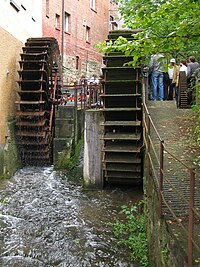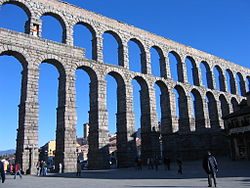Hydraulics



Hydraulics(fromAncient Greekὕδωρ(húdōr)'water', andαὐλός(aulós)'pipe')[2]is a technology andapplied scienceusingengineering,chemistry,and other sciences involving the mechanical properties and use ofliquids.At a very basic level, hydraulics is the liquid counterpart ofpneumatics,which concernsgases.Fluid mechanicsprovides the theoretical foundation for hydraulics, which focuses on applied engineering using the properties of fluids. In itsfluid powerapplications, hydraulics is used for the generation, control, and transmission ofpowerby the use ofpressurizedliquids. Hydraulic topics range through some parts of science and most of engineering modules, and cover concepts such as pipeflow,damdesign,fluidicsand fluid control circuitry. The principles of hydraulics are in use naturally in the human body within thevascular systemanderectile tissue.[3][4]
Free surface hydraulicsis the branch of hydraulics dealing withfree surfaceflow, such as occurring inrivers,canals,lakes,estuariesandseas.Its sub-fieldopen-channel flowstudies the flow in openchannels.
History[edit]
Ancient and medieval eras[edit]

Early uses of water power date back toMesopotamiaandancient Egypt,whereirrigationhas been used since the 6th millennium BC andwater clockshad been used since the early 2nd millennium BC. Other early examples ofwaterpower include theQanatsystem in ancient Persia and theTurpan water systemin ancient Central Asia.
Persian Empire and Urartu[edit]
In thePersian Empireor previous entities in Persia, thePersiansconstructed an intricate system of water mills, canals and dams known as theShushtar Historical Hydraulic System.The project, commenced byAchaemenidkingDarius the Greatand finished by a group of Roman engineers captured by Sassanian kingShapur I,[5]has been referred to byUNESCOas "a masterpiece of creative genius".[5]They were also the inventors[6]of theQanat,an underground aqueduct, around the 9th century BC.[7]Several of Iran's large, ancient gardens were irrigated thanks to Qanats.[8]
The Qanat spread to neighboring areas, including theArmenian highlands.There, starting in the early 8th century BC, theKingdom of Urartuundertook significant hydraulic works, such as theMenua canal.[9][7][10]
The earliest evidence ofwater wheelsandwatermillsdate back to theancient Near Eastin the 4th century BC,[11]specifically in the Persian Empire before 350 BCE, in the regions ofIraq,Iran,[12]andEgypt.[13]
China[edit]
Inancient Chinathere wasSunshu Ao(6th century BC),Ximen Bao(5th century BC),Du Shi(circa 31 AD),Zhang Heng(78 – 139 AD), andMa Jun(200 – 265 AD), while medieval China hadSu Song(1020 – 1101 AD) andShen Kuo(1031–1095). Du Shi employed awaterwheelto power thebellowsof ablast furnaceproducingcast iron.Zhang Heng was the first to employ hydraulics to provide motive power in rotating anarmillary sphereforastronomical observation.[14][15]
Sri Lanka[edit]

In ancient Sri Lanka, hydraulics were widely used in the ancient kingdoms ofAnuradhapuraandPolonnaruwa.[16]The discovery of the principle of the valve tower, or valve pit, (Bisokotuwa in Sinhalese) for regulating the escape of water is credited to ingenuity more than 2,000 years ago.[17]By the first century AD, several large-scale irrigation works had been completed.[18]Macro- and micro-hydraulics to provide for domestic horticultural and agricultural needs, surface drainage and erosion control, ornamental and recreational water courses and retaining structures and also cooling systems were in place inSigiriya,Sri Lanka. The coral on the massive rock at the site includescisternsfor collecting water. Large ancient reservoirs of Sri Lanka are Kalawewa (King Dhatusena), Parakrama Samudra (King Parakrama Bahu), Tisa Wewa (King Dutugamunu), Minneriya (King Mahasen)
Greco-Roman world[edit]
InAncient Greece,the Greeks constructed sophisticated water and hydraulic power systems. An example is a construction byEupalinos,under a public contract, of a watering channel forSamos,theTunnel of Eupalinos.An early example of the usage of hydraulic wheel, probably the earliest in Europe, is the Perachora wheel (3rd century BC).[19]
InGreco-Roman Egypt,the construction of the first hydraulic machineautomatabyCtesibius(flourished c. 270 BC) andHero of Alexandria(c. 10 – 80 AD) is notable. Hero describes several working machines using hydraulic power, such as theforce pump,which is known from many Roman sites as having been used for raising water and in fire engines.[20]

In theRoman Empire,different hydraulic applications were developed, including public water supplies, innumerableaqueducts,power using watermills andhydraulic mining.They were among the first to make use of thesiphonto carry water across valleys, and usedhushingon a large scale to prospect for and then extract metalores.They usedleadwidely inplumbingsystems for domestic and public supply, such as feedingthermae.[citation needed]
Hydraulic mining was used in the gold-fields of northern Spain, which was conquered byAugustusin 25 BC. The alluvialgold-mineofLas Medulaswas one of the largest of their mines. At least seven long aqueducts worked it, and the water streams were used to erode the soft deposits, and then wash the tailings for the valuable gold content.[21][22]
Arabic-Islamic world[edit]
In theMuslim worldduring theIslamic Golden AgeandArab Agricultural Revolution(8th–13th centuries), engineers made wide use ofhydropoweras well as early uses oftidal power,[23]and large hydraulicfactorycomplexes.[24]A variety of water-powered industrial mills were used in the Islamic world, includingfullingmills,gristmills,paper mills,hullers,sawmills,ship mills,stamp mills,steel mills,sugar mills,andtide mills.By the 11th century, every province throughout the Islamic world had these industrial mills in operation, fromAl-AndalusandNorth Africato theMiddle EastandCentral Asia.[25]Muslim engineers also usedwater turbines,employedgearsin watermills and water-raising machines, and pioneered the use ofdamsas a source of water power, used to provide additional power to watermills and water-raising machines.[26]
Al-Jazari(1136–1206) described designs for 50 devices, many of them water-powered, in his book,The Book of Knowledge of Ingenious Mechanical Devices,including water clocks, a device to serve wine, and five devices to lift water from rivers or pools. These includean endless belt with jugs attachedand a reciprocating device with hinged valves.[27]
The earliestprogrammable machineswere water-powered devices developed in the Muslim world. Amusic sequencer,a programmablemusical instrument,was the earliest type of programmable machine. The first music sequencer was an automated water-poweredfluteplayer invented by theBanu Musabrothers, described in theirBook of Ingenious Devices,in the 9th century.[28][29]In 1206, Al-Jazari invented water-powered programmable automata/robots.He described fourautomatonmusicians, including drummers operated by a programmabledrum machine,where they could be made to play different rhythms and different drum patterns.[30]
Modern era (c. 1600–1870)[edit]
Benedetto Castelli and Italian Hydraulics[edit]
In 1619Benedetto Castelli,a student ofGalileo Galilei,published the bookDella Misura dell'Acque Correntior "On the Measurement of Running Waters," one of the foundations of modern hydrodynamics. He served as a chief consultant to the Pope on hydraulic projects, i.e., management of rivers in the Papal States, beginning in 1626.[31]
The science and engineering of water in Italy from 1500-1800 in books and manuscripts is presented in an illustrated catalog published in 2022.[32]
Blaise Pascal[edit]
Blaise Pascal(1623–1662) studied fluid hydrodynamics and hydrostatics, centered on the principles of hydraulic fluids. His discovery on the theory behind hydraulics led to his invention of thehydraulic press,which multiplied a smaller force acting on a smaller area into the application of a larger force totaled over a larger area, transmitted through the same pressure (or exact change of pressure) at both locations.Pascal's lawor principle states that for an incompressible fluid at rest, the difference in pressure is proportional to the difference in height, and this difference remains the same whether or not the overall pressure of the fluid is changed by applying an external force. This implies that by increasing the pressure at any point in a confined fluid, there is an equal increase at every other end in the container, i.e., any change in pressure applied at any point of the liquid is transmitted undiminished throughout the fluids.
Jean Léonard Marie Poiseuille[edit]
A French physician,Poiseuille(1797–1869) researched the flow of blood through the body and discovered an important law governing the rate of flow with the diameter of the tube in which flow occurred.[33][citation needed]
In the UK[edit]
Several cities developed citywidehydraulic power networksin the 19th century, to operate machinery such as lifts, cranes, capstans and the like.Joseph Bramah[34](1748–1814) was an early innovator andWilliam Armstrong[35](1810–1900) perfected the apparatus for power delivery on an industrial scale. In London, theLondon Hydraulic Power Company[36]was a major supplier its pipes serving large parts of theWest End of London,Cityand theDocks,but there were schemes restricted to single enterprises such as docks andrailwaygoods yards.
Hydraulic models[edit]
After students understand the basic principles of hydraulics, some teachers use a hydraulicanalogyto help students learn other things. For example:
- TheMONIAC Computeruses water flowing through hydraulic components to help students learn about economics.
- Thethermal-hydraulic analogyuses hydraulic principles to help students learn about thermal circuits.
- The electronic–hydraulic analogyuses hydraulic principles to help students learn about electronics.
Theconservation of massrequirement combined with fluidcompressibilityyields a fundamental relationship between pressure, fluid flow, and volumetric expansion, as shown below:[37]
Assuming an incompressible fluid or a "very large" ratio of compressibility to contained fluid volume, a finite rate of pressure rise requires that any net flow into the collected fluid volume create a volumetric change.
See also[edit]
Notes[edit]
- ^NEZU Iehisa (1995),Suirigaku, Ryutai-rikigaku,Asakurae Shoten, p. 17,ISBN978-4-254-26135-6.
- ^Chisholm, Hugh,ed. (1911)..Encyclopædia Britannica.Vol. 14 (11th ed.). Cambridge University Press. p. 35.
- ^"The Circulatory System: The Hydraulics of the Human Heart".1 May 2017. Archived fromthe originalon 1 May 2017.Retrieved19 March2019.
- ^Meldrum, David R.; Burnett, Arthur L.; Dorey, Grace; Esposito, Katherine; Ignarro, Louis J. (2014). "Erectile Hydraulics: Maximizing Inflow While Minimizing Outflow".The Journal of Sexual Medicine.11(5): 1208–20.doi:10.1111/jsm.12457.PMID24521101.
- ^abCentre, UNESCO World Heritage."Shushtar Historical Hydraulic System".Whc.unesco.org.Retrieved1 September2018.
- ^Goldsmith, Edward (2012).The qanats of Iran.
- ^abLombard, Pierre (1991)."Du rythme naturel au rythme humain: vie et mort d'une technique traditionnelle, le qanat".MOM Éditions.20(1): 69–86.
- ^"The qanats of Iran · Edward Goldsmith".archive.is.14 April 2013. Archived fromthe originalon 14 April 2013.Retrieved1 September2018.
- ^Viollet, Pierre-Louis (2004).L'hydraulique dans les civilisations anciennes: 5000 ans d'histoire(in French). Presses des Ponts.ISBN978-2-85978-397-6.
- ^Burney, Charles (1972)."Urartian Irrigation Works".Anatolian Studies.22:179–186.doi:10.2307/3642562.ISSN0066-1546.JSTOR3642562.S2CID131657710.
- ^Terry S. Reynolds,Stronger than a Hundred Men: A History of the Vertical Water Wheel,JHU Press, 2002ISBN978-0-8018-7248-8,p. 14
- ^Selin, Helaine (2013).Encyclopaedia of the History of Science, Technology, and Medicine in Non-Western Cultures.Springer Science & Business Media.p. 282.ISBN978-94-017-1416-7.
- ^Stavros I. Yannopoulos; Gerasimos Lyberatos; Nicolaos Theodossiou; Wang Li; Mohammad Valipour; Aldo Tamburrino;Andreas N. Angelakis(2015)."Evolution of Water Lifting Devices (Pumps) over the Centuries Worldwide".Water.7(9).MDPI:5031–5060.doi:10.3390/w7095031.
- ^Fu, Chun gian g; Liping., Yang; N., Han, Y.; Editorial., Asiapac (2006).Origins of Chinese science and technology.Asiapac.ISBN978-981-229-376-3.OCLC71370433.
{{cite book}}:CS1 maint: multiple names: authors list (link) - ^"Armillary Sphere".Library of Congress.Retrieved10 July2022.
- ^"SriLanka-A Country study"(PDF).USA Government, Department of Army. 1990. Archived fromthe original(PDF)on 5 September 2012.Retrieved9 November2011.
- ^"SriLanka – History".Asian Studies Center, Michigan State University. Archived fromthe originalon 28 December 2011.Retrieved9 November2011.
- ^"Traditional SriLanka or Ceylon".Sam Houston State University. Archived fromthe originalon 27 September 2011.Retrieved9 November2011.
- ^Tomlinson, R. A. (2013). "The Perachora Waterworks: Addenda".The Annual of the British School at Athens.71:147–8.doi:10.1017/S0068245400005864.JSTOR30103359.S2CID129173283.
- ^Museum, Victoria and Albert. "Catalogue of the mechanical engineering collection in the Science Division of the Victoria and Albert Museum, South Kensington, with descriptive and historical notes." Ulan Press. 2012.
- ^Centre, UNESCO World Heritage."Las Médulas".Whc.unesco.org.Retrieved13 June2017.
- ^"Las Médulas".Castilla y León World Heritage UNESCO(in European Spanish). 30 October 2014.Retrieved13 June2017.
- ^Ahmad Y. al-Hassan(1976).Taqi al-Din and Arabic Mechanical Engineering,pp. 34–35. Institute for the History of Arabic Science,University of Aleppo.
- ^Maya Shatzmiller,p. 36.
- ^Adam Robert Lucas (2005), "Industrial Milling in the Ancient and Medieval Worlds: A Survey of the Evidence for an Industrial Revolution in Medieval Europe,"Technology and Culture46(1), pp. 1–30 [10].
- ^Ahmad Y. al-Hassan,Transfer Of Islamic Technology To The West, Part II: Transmission Of Islamic EngineeringArchived18 February 2008 at theWayback Machine
- ^Al-Hassani, Salim (30 January 2008)."800 Years Later: In Memory of Al-Jazari, A Genius Mechanical Engineer".Muslim Heritage.The Foundation for Science, Technology, and Civilisation.Retrieved30 April2015.
- ^Koetsier, Teun (2001), "On the prehistory of programmable machines: musical automata, looms, calculators",Mechanism and Machine Theory,36(5), Elsevier: 589–603,doi:10.1016/S0094-114X(01)00005-2.
- ^Kapur, Ajay; Carnegie, Dale; Murphy, Jim; Long, Jason (2017)."Loudspeakers Optional: A history of non-loudspeaker-based electroacoustic music".Organised Sound.22(2).Cambridge University Press:195–205.doi:10.1017/S1355771817000103.ISSN1355-7718.
- ^Professor Noel Sharkey,A 13th Century Programmable Robot (Archive),University of Sheffield.
- ^"The Galileo Project – Science – Benedetto Castelli".Galileo.rice.edu.
- ^Andrews, Mark E. 2022.The Science and Engineering of Water: An Illustrated Catalogue of Books and Manuscripts on Italian Hydraulics 1500-1800.Toronto: AE Publications.
- ^Sutera and Skalak, Salvatore and Richard. The History of Poiseuille's Law. Annu. Rev. Fluid Mech. 1993. 25: 1-19.
- ^"Joseph Bramah".Robinsonlibrary.23 March 2014. Archived from the original on 24 October 2006.Retrieved8 April2014.
{{cite web}}:CS1 maint: unfit URL (link) - ^"William George Armstrong, Baron Armstrong of Cragside (1810-1900)".Victorianweb.org.22 December 2005.Retrieved8 April2014.
- ^"Subterranea Britannica: Sites: Hydraulic power in London".Subbrit.org.uk.25 September 1981.Retrieved8 April2014.
- ^"Archived copy"(PDF).Archived fromthe original(PDF)on 23 April 2018.Retrieved23 April2018.
{{cite web}}:CS1 maint: archived copy as title (link)
References[edit]
- Rāshid, Rushdī; Morelon, Régis (1996),Encyclopedia of the history of Arabic science,London: Routledge,ISBN978-0-415-12410-2.

